There are several things to think about when shooting motion. The trouble with shooting motion is getting a photo sharp if you want to to freeze the motion and retain detail, or choosing to blur the motion. If you choose to freeze the motion and have the moving object or person in focus, it is still important to represent the motion of the subject in some way.
Freezing Motion
In order to free motion, the priority should be to set your shutter speed very high, to something upwards of 1/300th of a second. (aperture should then be adjusted appropriately to compensate for the fact that a fast shutter speed lets in very little light - that is, the aperture should be very wide). This number could be even higher, such as 1/1000th of a second in the case that the object is moving very very quickly or that the object is extremely close to the camera, in which case it is going much quicker relative to the camera lens.
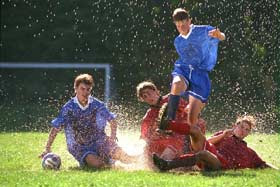 In this shot of soccer players, from Kodak: Photographing Sports and Action, the players as well as the water drops are frozen, clearly visible. The use of a VERY fast shutter speed means that the drops were exposed just at the moment they were in the air, and the players stopped in their motion. In this way, we are able to clearly see the strained looks on the faces and the effort the kids are putting in to get to the ball. It's also nice to see the confusing tangle of players and water sharply to see what's going on.
In this shot of soccer players, from Kodak: Photographing Sports and Action, the players as well as the water drops are frozen, clearly visible. The use of a VERY fast shutter speed means that the drops were exposed just at the moment they were in the air, and the players stopped in their motion. In this way, we are able to clearly see the strained looks on the faces and the effort the kids are putting in to get to the ball. It's also nice to see the confusing tangle of players and water sharply to see what's going on.Blurring Motion
Can be done in the opposite way. By having a slow shutter speed, from the time of opening the shutter to the time when it closes again, the subject has traveled from point A to point B. The area in between will capture all the motion in between leaving a blurred subject which shows exactly what path the subject took. The movements are annotated in the following, where starting and ending points of motion are shown and the spots in between blurred.
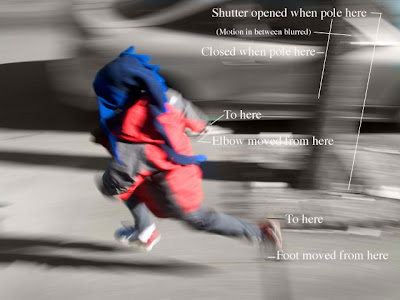
Panning Panning is a technique for making the subject in focus and the background or any moving parts of the subject in motion and blurred. This is achieved by moving the camera with the action of the subject. You have to keep the subject in the viewfinder and have it moving slowly and steadily at the same speed as the subject before, during, and after the shutter is opened (using a relatively slow shutter speed). In this way, the subject will be sharp, while the background will be blurred, usually streaked in the direction of motion to show how rapidly the subject is moving past.
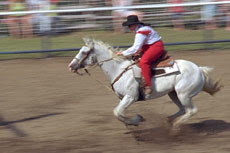 In this case, from Kodak: Photographing Sports and Action, the top of the horse and the rider are sharp and in focus, while the feet of the horse are blurred and you can see the motion. The background is also blurred, but differently than the feet, for instead of being out of focus, it is streaked and looks like you are speeding by with the horse. It's also worth noting that the horse is off center, as when photographing motion, it is helpful to leave space in front of the subject to more or less give them room in the frame.
In this case, from Kodak: Photographing Sports and Action, the top of the horse and the rider are sharp and in focus, while the feet of the horse are blurred and you can see the motion. The background is also blurred, but differently than the feet, for instead of being out of focus, it is streaked and looks like you are speeding by with the horse. It's also worth noting that the horse is off center, as when photographing motion, it is helpful to leave space in front of the subject to more or less give them room in the frame.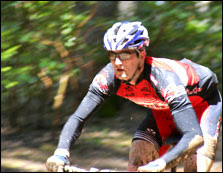 In this example, from Photoshop Methods of Expressing Motion in Photography Tutorial, the rider is also in an interesting position. While he is not sharp necesarily, he is less blurred than the background, which seems to be going by at an angle. The effect of panning angularly is very interesting, because you can see the direction of motion and the diagonal nature of the streaks and the riders direction of motion makes the image dynamic.
In this example, from Photoshop Methods of Expressing Motion in Photography Tutorial, the rider is also in an interesting position. While he is not sharp necesarily, he is less blurred than the background, which seems to be going by at an angle. The effect of panning angularly is very interesting, because you can see the direction of motion and the diagonal nature of the streaks and the riders direction of motion makes the image dynamic.Blurring Only the Subject
Is done using a tripod and a slow shutter speed. In this way, when the shutter opens for a long time, the background will not move, and hence will show up clear and sharp. However, allowing the shutter to be open long means that whatever is moving in the viewfinder will be blurred. This is commonly done with headlights of cars and trains.
This example, from Kudos Photography Portfolio, shows headlights blurred along highway. It is interesting because the image appears to be in focus, as the sides of the highway are clear, and the bright headlights show clearly the motion of the cars and define the direction of the highway.
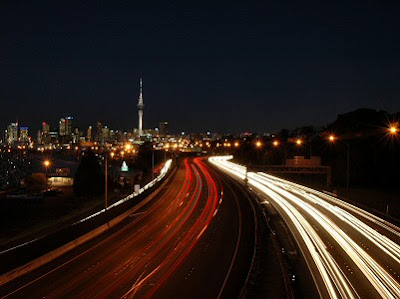

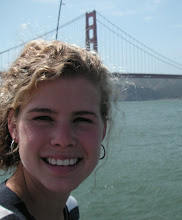
No comments:
Post a Comment